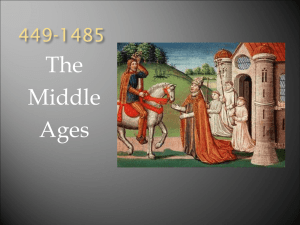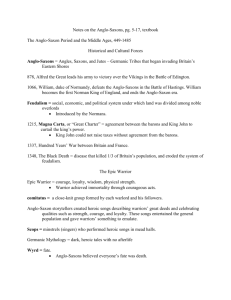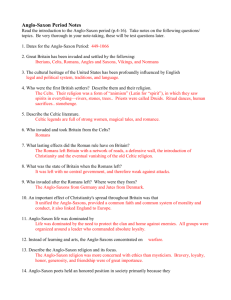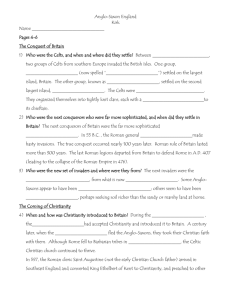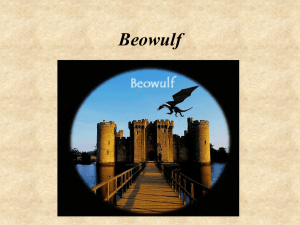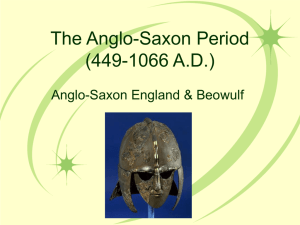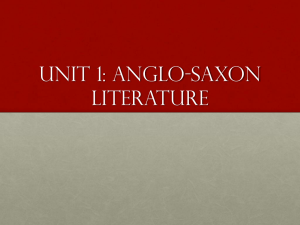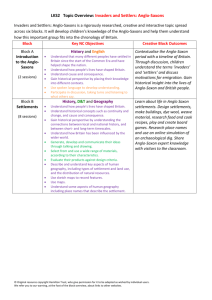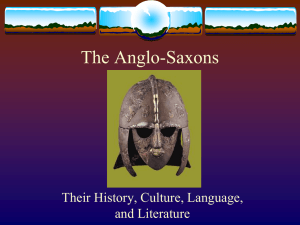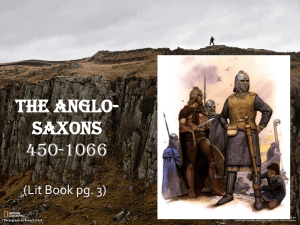File
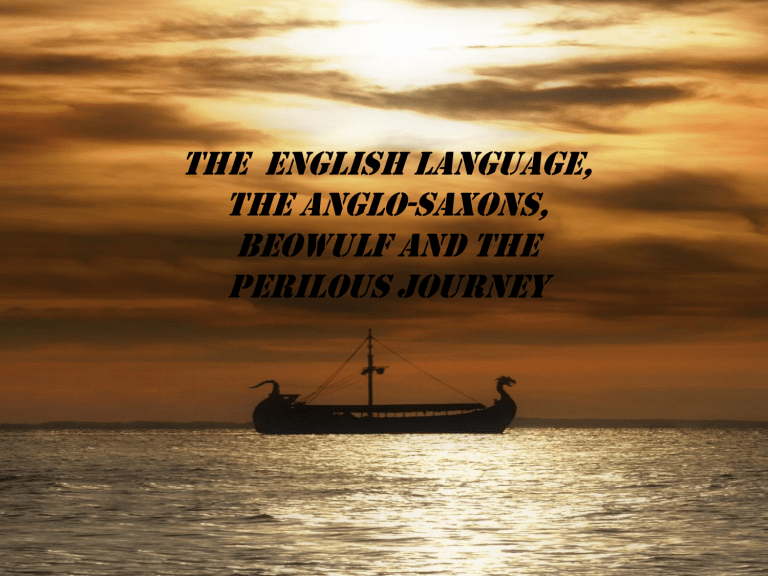
The English Language,
Beowulf
Beowulf and the
Perilous Journey
Ms. Scully
A Brief History of Britain up to the end of the
Medieval Period!!!
Quick Question:
What do the terms Britain, Great Britain, the British Isles and the United Kingdom refer to? Are they terms for the same land and country?
The Origins of Language
7000 BP (before present): Indo European
Language (I.E.)
Early British History:
The first persons in England were the
Druids and Celts.
Druids were a gathering of priests and are known for Stonehenge
The Celts and Druids eventually merged.
The Druids worshipped goddesses; conquering tribes did away with religion and the goddesses.
Early British History:
I. 43-410 A.D. – Roman Rule
A. Roman Empire is at its height – it is expanding around the European continent.
B. Britain is invaded by the Romans (Julius
Caesar)
Rome settles and builds in England, completely subduing the Celts
C. Various Roman Governors rule Britain
D. The Romans introduce their language, culture and law – roads, songs, literature, architecture, pastimes (Roman Baths)
II. 410-1066 – Anglo-Saxon and
Viking Rule
A. Collapse of the Roman Empire – Romans abandon Britain, leaving the Celts without an army or way of defending themselves.
B. Britain is plunged into the “Dark Ages”
1. No literacy or culture
C. 3 Germanic tribes invade Britain
1. Angles
2. Saxons
3. Jutes
The Celts are pushed into Scotland, Ireland and
Wales
Latin becomes the language of the learned
The Anglo-Saxons
449-1066
Arrived when the Romans left.
Divided Britain into independent principalities each with their own ruler.
Christianity returned and linked Britain with Europe, which helped to unify the Anglo-Saxons, although their pagan religion remained strong.
Fame, success and survival depended on the loyalty to the leader of the clan.
A-S religion was more concerned with ethics than mysticism
Bards (scops) were as important as fighters, hunters, fishers, and farmers.
They were accompanied by glemons
(musicians) who played on harps.
Fame in the bard’s mournful poetry was a hero’s only consolation after death.
Christian monks preserved Anglo-Saxon culture and literary traditions.
“The Northmen”
Comprised of Danes, Swedes and
Norwegians
The Vikings were peasants and nobles who sailed from their land to attack and plunder villages
Purpose: Gain more land and property
Alfred the Great:
During this time period we have Alfred the Great.
871-899: Alfred the Great of Wessex became King of England
(parts of it) and was known for being a great scholar.
He defeated Vikings who had been attacking other English kings and lands and he negotiated peace with the Danish leaders.
He developed defendable plots of land called buroughs as market places and spread literacy by having important texts translated from Latin into Anglo-Saxon.
One such important text was the Anglo-Saxon Chronicle which celebrated Alfred and the history of Wessex
Alfred’s legacy is the unification of the lands ruled by other
Anglo-Saxon kings into what would eventually become
England.
The Sutton Hoo Ship Burial
Remnants of an Anglo-Saxon royal burial were found at the town of Sutton Hoo.
Treasures were found in mounds scattered about the area, including an undisturbed ship filled with artifacts.
This discovery proved that the Anglo-
Saxons were civilized.
III. 1066-1154 – Norman Rule
A. King Edward I “The Confessor” dies leaving
England to his cousin William of Normandy (a bastard).
B. There are three claimants to the throne: William of
Normandy, Harold Hardrada (Edward’s nephew) and
Harold of Norway (Viking)
C. Harold Hardrada defeats Harold of Norway in battle.
D. William launches an attack on England and meets Harold Hardrada at Hastings, England.
The Battle of Hastings
The two armies meet at the town of
Hastings, England.
Oct. 14, 1066 – Battle of Hastings
Bloody battle – many die
Harold is killed by an arrow through his eye.
The Bayeux Tapestry
232 feet long; 20 inches high
Embroidered panel of wool on linen
Shows the Battle of Hastings.
The tapestry can be seen today in a chapel in Bayeux, France.
The Bayeux Tapestry
William the Conqueror
William becomes king and is known as
William the Conqueror.
In order to command England, William builds castles at each of the cities he stops at on his way to London.
The most famous of his castles is the
White Tower in the Tower of London.
Results of the Norman Conquest
There was now a major division between the nobles and the peasants.
The nobles (William’s) spoke French
The English peasants spoke old English
French: beef
English: cow
The Normans brought accentual syllabic poetry
(iambic pentameter etc…)
*Monosyllabic words are mostly Anglo-Saxon: blood, puff. They are more pictoral, concrete and sensory.
The English Language
The English that emerged after the Battle of Hastings was drastically different
449 to 1066: Old English
1066-~1485: Middle English (Chaucer)
Great Vowel Shift (vowels shift higher, or pronounced higher in the mouth; ex: route)
1485-2012: Modern English
(Shakespeare is considered middle/modern
English)
Old English
A combination of influences!
Heavy Germanic influence
Nouns were either masculine, feminine or neuter
Relied on word form rather than word order
For special purposes, a different alphabet was used
(futhorc) which was composed of letters known as runes.
Mainly an oral language.
The Catholic Church influenced OE; missionaries brought words like paper, altar, candle and school
The Vikings also left many words in the English lang.
Narrative
Epic
Monologue
Types of Poetry
Lyric
Personal
Highly emotional
Odes
Elegies
Sonnets
Dramatic
Theater
Old English Poetry
Alliterative Verse
1. Uses a lot of alliteration
2. Caesura – there are spaces in the middle of the lines (poetic breaks in sound)
3. 4 beats per line
4. a a a _ (a = alliteration) – look at example text
6 Themes common to Anglo-
Saxon Poetry
1. Loneliness and suffering
2. Temporal matters are fleeting
3. Northern winters are terrifying
4. The sea is immense, cruel and unforgiving
5. Loss of a retainer is catastrophic (a liege lord)
6. Ubi Sunt: mourning for what has gone before; mourning for the past
Terms to Know for Beowulf :
1. Comitatus: Community. The bond between the lord and his warriors.
2. Scop: A storyteller or poet
3. Kennings (Epithets): Metaphoric compound words.
Examples: Bone-house = rib cage or the body
Whale’s road = the sea
Sky’s candle = the sun
4. Epic Hero: A larger than life figure from history or legend. Qualities: courage, loyalty, honor
5. In Media Res: “In the middle of things” The story begins in the middle of the action.
6. Mead: rich, thick wine; mead halls (gathering places)
History of
Beowulf:
I. Epic Poem: a. Tells of the adventures of heroes (from history or legend) b. Epic Hero Traits (Anglo-Saxon) – courage, loyalty, honor, generosity
II. Beowulf: a. written between 700-1000 A.D.
b. Composed in Old English (Anglo-Saxon) and found, along with “The Wanderer” in the Book of Exeter in 1020.
d. They are elegiac – poems of mourning c. Earliest major work of English poetry d. Takes place in Scandinavia (Denmark) e Only 1 surviving copy left – British Library in
London f. Over 300 lines long, unrhymed, 4 beat alliterative verse.
Mothers are found to be greater, more evil and powerful in epic stories (Grendal’s mother is much more terrifying than her son).
Anglo-Saxons valued mothers, however a male hero always triumphs.
